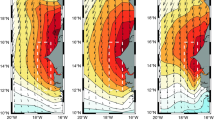Abstract
Global satellite sea surface temperature (SST) measurements and NCEP/NCAR reanalysis wind data for the period of 1982–2009 have been used to study the relationship between long-term variability of oceanic frontal zones (OFZ) and large-scale atmospheric forcing. Statistically significant positive correlations between the maximum magnitude of the meridional gradient of zonally averaged SST and meridional shear of zonal wind (which is an estimate of the Ekman convergence intensity) were found for all subpolar and subtropical OFZ of the World Ocean. Variability of the latitudinal position of OFZ cores may be associated with Ekman advection variability due to zonal wind variations. Strengthening of zonal wind results in a shift of subpolar OFZ cores to the south/north in the Northern/Southern hemispheres.
Similar content being viewed by others
References
A. S. Kazmin, “Variability of large-scales oceanic frontal zones: analysis of global satellite data,” Sovrem. Probl. Distantsionnogo Zondirovaniya Zemli Kosmosa 9 (1), 213–218 (2012).
W. P. M. de Ruijer, “Effects of velocity shear in advective mixed-layer models,” J. Phys. Oceanogr. 13 (9), 1589–1599 (1983).
E. Kalnay, M. Kanamitsu, R. Kistler, et al., “The NCEP/NCAR 40-year reanalysis project,” Bull. Am. Meteor. Soc. 77, 437–471 (1996).
A. S. Kazmin and M. M. Rienecker, “Variability and frontogenesis in the large-scale oceanic frontal zones,” J. Geophys. Res., C: Oceans Atmos. 101 (1), 907–921 (1996).
H. Nakamura and A. S. Kazmin, “Decadal changes in the North Pacific oceanic frontal zones as revealed in ship and satellite observations,” J. Geophys. Res., C: Oceans Atmos. 108 (3), 3078–3094 (2003).
G. I. Roden, “Aspects of the mid-Pacific transition zone,” J. Geophys. Res. 75 (6), 1097–1109 (1970).
G. I. Roden, “Temperature and salinity fronts at the boundaries of subarctic-subtropical transition zone in the western Pacific,” J. Geophys. Res. 77 (36), 7175–7178 (1972).
G. I. Roden, “On North Pacific temperature, salinity, sound velocity and density fronts and their relation to the wind and energy flux fields,” J. Phys. Oceanogr. 5 (4), 557–571 (1975).
A. M. P. Santos, A. S. Kazmin, and A. Peliz, “Decadal changes in the Canary upwelling system as revealed by satellite observations: their impact on productivity,” J. Mar. Res. 63 (2), 359–379 (2005).
Author information
Authors and Affiliations
Corresponding author
Additional information
Original Russian Text © A.S. Kazmin, 2016, published in Okeanologiya, 2016, Vol. 56, No. 2, pp. 197–202.
Rights and permissions
About this article
Cite this article
Kazmin, A.S. Long-term variability of oceanic frontal zones associated with large-scale atmospheric forcing. Oceanology 56, 182–187 (2016). https://doi.org/10.1134/S0001437016020107
Received:
Accepted:
Published:
Issue Date:
DOI: https://doi.org/10.1134/S0001437016020107




